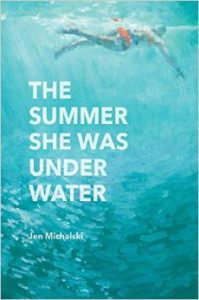
Nothing is as it seems in Jen Michalski’s latest novel, The Summer She Was Under Water. Michalski integrates this tension between the real and the illusory into every dimension of a story that spirals unrelentingly toward the truth.
The plot centers on Sam Pinski, an angsty writer in her early 30s, who spends the Fourth of July weekend at her parents’ lakeside cabin in Maryland along with her friend, Eve. It’s the first time the Pinski family has been together in years, and it’s been 15 years that Sam has lived with an uncomfortable secret involving her brother, Steve, who left home as a teenager. Sam is troubled by the prospect of reuniting with her mercurial brother, and is reeling from her broken engagement to her long-time boyfriend, Michael, whom Sam’s mother has invited for the weekend. But Sam’s emotional turmoil is deeper than meets the eye, as she struggles with anger, shame, and low self-worth. Over four days, the family’s dysfunction comes to light: Sam’s father’s abusive behavior and struggles with alcoholism; her mother’s denial of the family’s troubled dynamics; and the unspoken truth about Sam and Steve’s relationship.
Three separate storylines unravel: the present events of the holiday weekend at the cabin; the retelling of the family’s history and Sam’s relationship with Michael; and the novel Sam is writing about a pregnant man, inspired by Steve. As the storylines roll out, a sort of fog, not unlike the sensation of being under water, obscures the reader’s sense of time. As the narrator so elegantly says: “They are vague feelings, a delicious nothingness that obscures details the same way a flash washes out a photograph.” There are a few cultural references—songs, a radio broadcast, old mail, a physical map—to suggest the action might be taking place sometime in the late 1990s or early 2000s, but the precise moment is hazy. Time itself, after all, is a slippery thing. The novel relishes this ambiguity, leaving the reader, at times, with more questions than answers.

There are, however, a few anchoring moments of clarity and beauty in the whiskey- and cigarette-infused haze of the action. Michalski is a master of detail, and every scene in The Summer She was Under Water is rich with description. Like this gem: “The sun is soft, a lamp behind a latticework of bending trees as the afternoon begins to fade.” Or this one: “[T]he sky was cloudless, miles of black felt paper, its ceiling high, topped with stars.” Michalski’s prose is most piercing when the narrator describes the physicality of the present moment:
And the laughter poured into all the cracks in her bones and joints and skin and sealed her tight.
The past she thought she’d shed always seemed to slide down her neck and into the small of her back, her body tight, when she wasn’t expecting it. Like when she was happy. Or when she was jogging or eating walnuts.
Her flesh has begun to sag a little at the knees and elbows, as if the contents of her travels have lessened, thinned her body starved for more resonance, weight.
Smells so honest and strong they fortified his soul, beautiful, open places, and plenty of work for his hands.
As the novel accelerates toward Sam’s coming to terms with the past, the story pulls the reader into a dark and uncomfortable place. This is where Michalski’s ability to engage the reader’s compassion and sensitivity is most profound. The Pinskis, to be sure, have their problems, but Michalski invites the reader to consider the family in a softer light as they navigate the currents of time and loss.
Like water—that ever-changing element—the narrative transforms from a reckoning with the past to an acceptance of the future and all its maybes. And in doing so, it challenges the reader.




